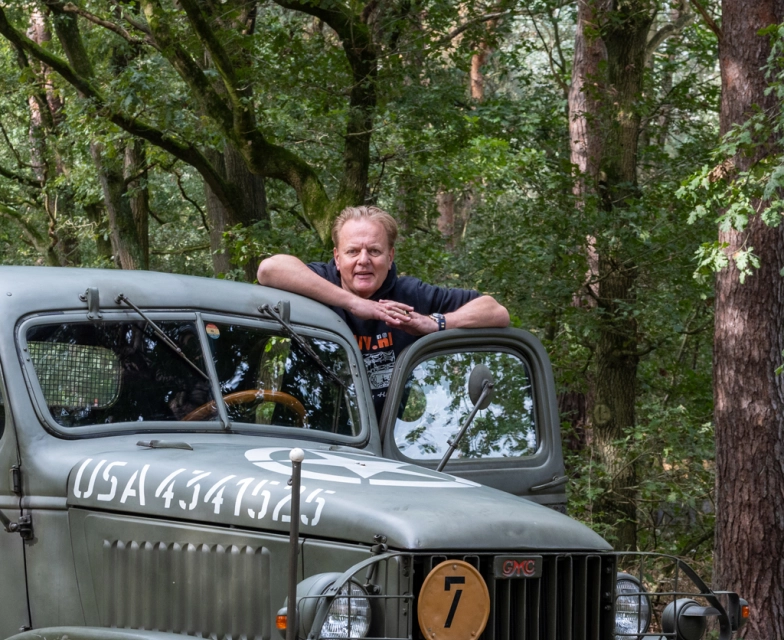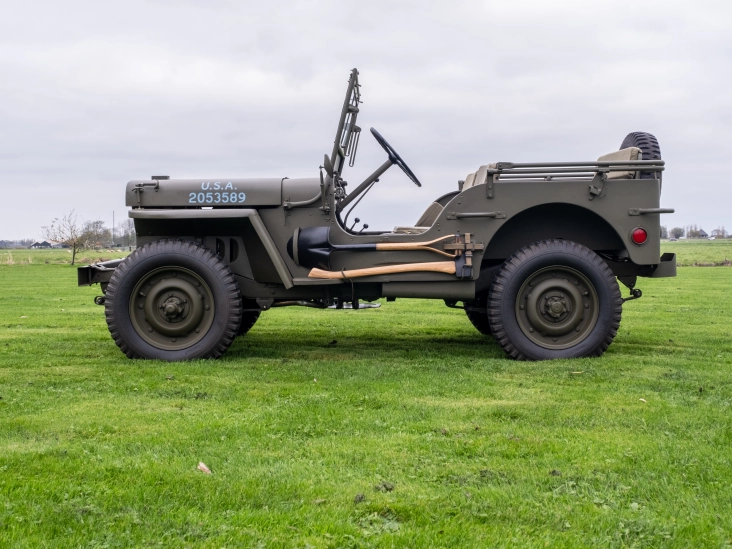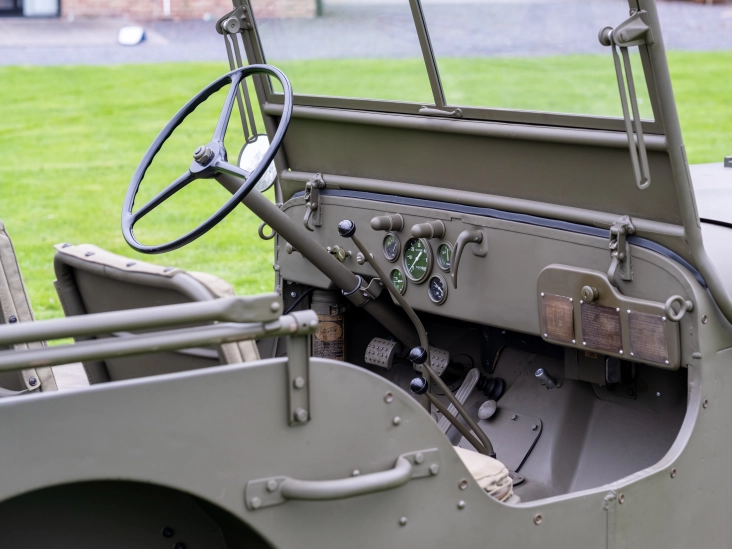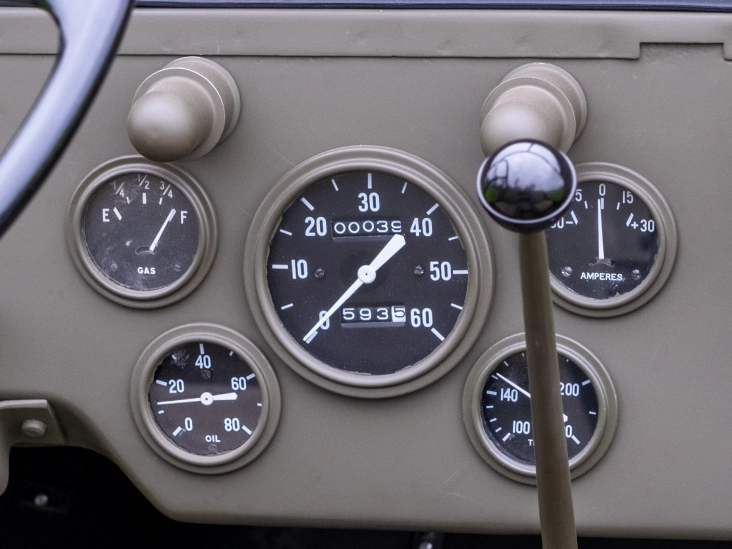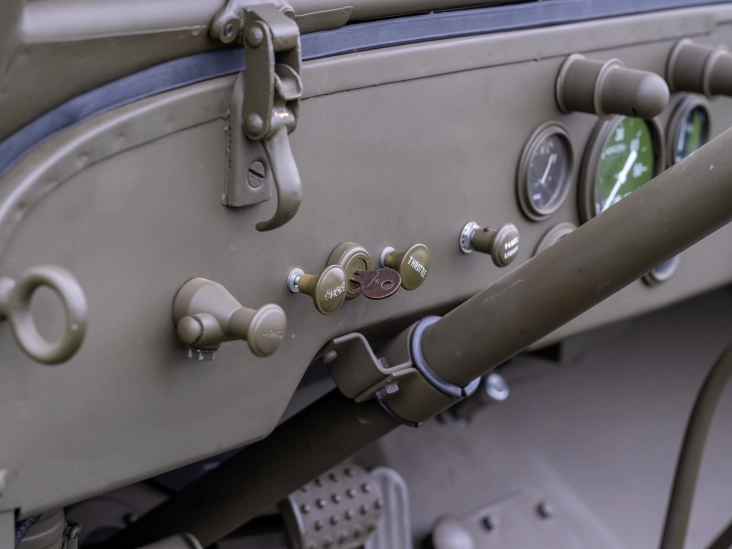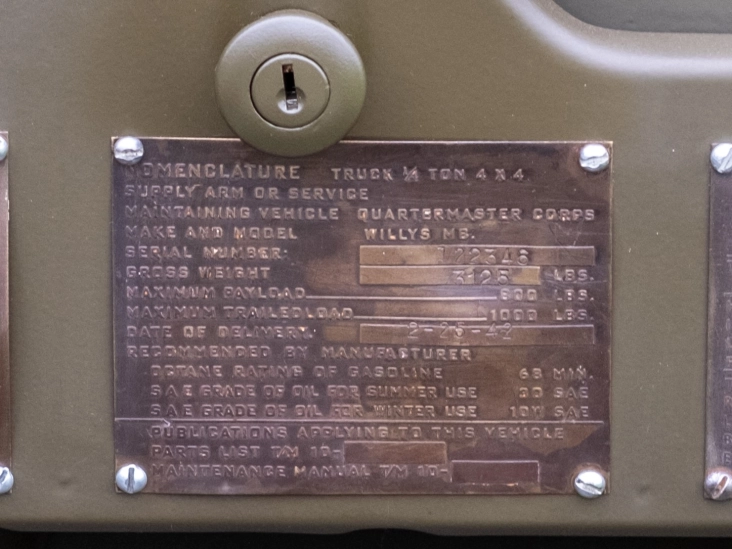1942 Willys MB 'slat grille'
This Willys MB, produced on 25-02-1942, is part of the final series of "slat grille's." This model already features a glove compartment, which earlier 'slat grills' did not have. This last series was manufactured only between late February and May 1942, making it exceptionally rare.
Given the unique status of this Jeep, the owner spared no expense to restore it to perfection, precisely aligned with its production date to ensure historical accuracy. An absolutely stunning example.
Details
Conditions
The restoration was carried out by a renowned company, bringing the Willys to a "factory-new" condition, with the engine completely overhauled. Every detail was aligned with the production date to ensure historical accuracy. Since the restoration, approximately two years ago, the jeep has rarely been driven. This is a Willys MB slat grille in concours condition, as clearly visible in the photos.
Technical details
- Manufacturer
- Willys-Overland
- Model
- MB slat grille
- Manufacturing date
- 25 February 1942
- Serial number
- 122346
- Length
- 11 ft (3.35 m)
- Width
- 5 ft 2 in (1.57 m)
- Height (top up)
- 5 ft 10 in (1.77 m)
- Height (top down)
- 4 ft 4 in (1.32 m)
- Weight
- 2.453 lb (1.113 kg)
- Max. speed
- 65 mph (105 km/h)
- Operational range
- 300 mi (480 km)
- Engine
- 134 cu in (2.2 L) Inline 4, Willys L134, 60 hp (45 kW)
- Crew
- 4 (1 driver + 3 passengers)
- Production numbers
- 25.808 (all slatt grill models)
- Road registration
- Yes (Dutch)
History
After securing the contract to manufacture the WWII quarter-ton truck, Willys produced the early Willys MA model, which evolved into the Willys MB. These initial MB jeeps, built from November 1941 to March 1942, are recognized for their unique “slat grille” made from iron bar stock. This distinctive feature, limited to the first 25,808 units, was later replaced by Ford's stamped steel grille design, which reduced production time and weight while incorporating airflow deflectors.
Differences
The slat grille MB differed significantly in both structure and functionality compared to later models. Early models lacked a glove box, meaning components like the fire extinguisher were mounted near the passenger side toe board. Early production also used a shorter windshield frame, which was later extended by two inches to accommodate taller drivers. Up to truck no. 164,554, the windshield featured push-button fasteners for the canvas top and uniquely placed hold-down catches to secure the windshield in its folded position. Other distinguishing features included the brass data plates, a solid black plastic steering wheel, and a speedometer graduated in 5 mph increments, along with a fuel gauge labeled “GAS” instead of “FUEL.”
The vehicle's body design included several unique elements, such as two separate small hinges on the toolbox lids instead of a continuous hinge, and locks keyed to match the H700 ignition key. The slat grille MBs were also distinct for their fuel tank well, which was box-shaped rather than rounded as seen in later models. The early jeeps did not include certain accessories, such as trailer light sockets or fuel can carriers, until mid-1943. Another distinctive feature of the slat grille jeeps was the use of rubber parts, including rubber shifter boots, seals around the fuel tank, and rubber hood blocks, which were later replaced with wood as wartime material rationing increased.
Mechanically, early MB models were prone to veer to the left during heavy braking due to the axle-mounted bell crank, which was later corrected with the addition of a torque reaction spring to the driver’s side front spring. The frame and suspension also included early design traits, such as solid disc wheels on pre-standardized units and early Kelsey-Hayes solid wheels used until truck no. 120,700. The AC Spark Plug Co. provided a distinctive “hat style” air filter for these early jeeps, which was later replaced by the Oakes model in subsequent versions.
The slat grille MBs came with various specialized components not found on later models. For instance, the fuel tank was equipped with a narrow neck that required a smaller cap, and the exhaust system initially used a round muffler before switching to an oval design. These jeeps also had a Holland Hitch Co. T-60-A pintle hook without trailer safety chain eye bolts, which were added in later production.
Restoration of these early jeeps is often a painstaking process due to the scarcity of original parts and the intricate details unique to each production phase. Due to their unique features and limited production run, the slat grille MBs have become a rare and prized collector’s item.
Fun Fact: Grille or Grill?
Collectors and enthusiasts seem to use the two terms interchangeably have you ever wondered which is correct?
Grammatically speaking, “grill” — both as a verb and as a noun— relates to cooking food over a metal structure placed over a fire.
“Grille,” on the other hand, refers to a metal structure of bars built around or across something to ensure its protection.
Based on that, the thing protecting the radiator on either a Willys or Ford Jeep is a "grille."
But if you really want to be correct, Ord 9 SNL G-503, List of Service Parts for Truck, 1/4-ton, 4x4, Command Reconnaissance (Ford Model GPW; Willys, Model MB), refers to that protective piece in front of the radiator as neither. Instead, it labels it as a "guard" (part number WO-A3615).


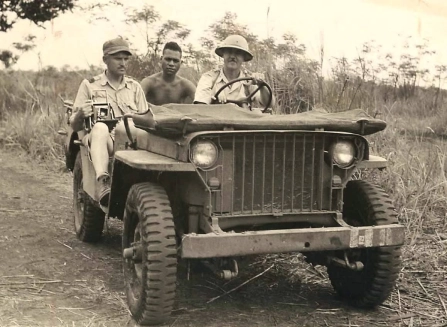

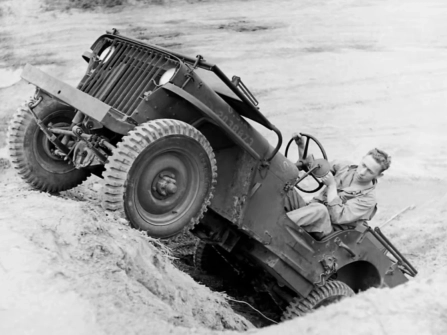



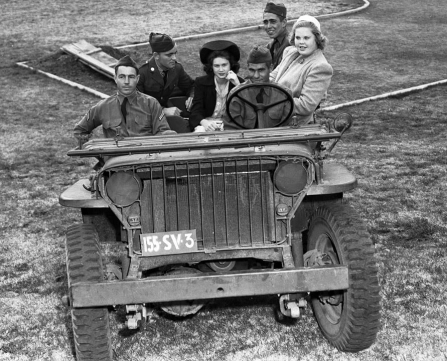

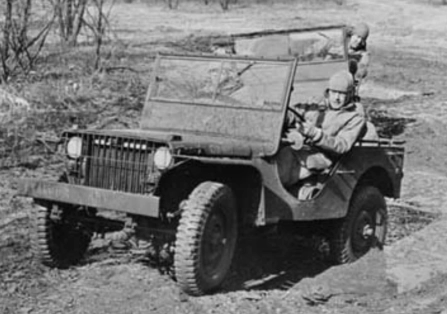
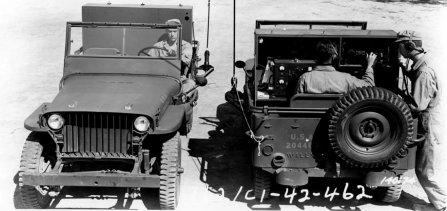

Note to buyer
BUYER’S PREMIUM
On all lots a buyer’s premium of 16,5% of the hammer price is charged. Over this buyer’s premium a 21% sales tax (VAT) will be applicable.
PARTS, ACCESSOIRIES & MILITARIA
Spare parts, accessories and militaria are sold in as-is condition and delivered without any guarantee of functioning.
VEHICLES & VEHICLE RELATED EQUIPMENT
Cars, motorcycles, trucks, cannons or howitzers, armored vehicles, and tanks are sold in as-is condition, with no technical guarantee and guarantee of authenticity and with or without registration.
ARMS & WEAPONS
The Auction House will not supply ANY item unless the correct paperwork and licensing – if needed – has been supplied by the Buyer in full.
If required and applicable (fire)arms can be made inoperable or permanently disabled by BAIV in The Netherlands as being a licensed Arms & Weapons Dealer Registration Nr. NL20191618779. In this case all relevant cost will be charged to the Buyer in addition and have to be paid in advance in full. Collection by appointment only!
MARGIN/ VAT
However, for most of the lots 21% sales tax (VAT) over the hammer price will be not applicable, it might be that in some specific cases sales tax (VAT) over the hammer price will be charged. In such a case this will be specifically specified in the lot description. For all other lots the margin scheme will be applicable. For more info see our General Conditions of Sale Article 9 on our website; www.tracksandtrade.com
COLLECTION
Parts, accessories, and militaria
The collection of the lots, subject to payment, is by appointment only. The date and time for collecting the goods will be arranged in consultation with the seller.
Vehicles
Vehicles can be picked up, subject to payment, by appointment only. The date and time for collecting vehicles will be arranged in consultation with the seller.
Handling costs for the removal of the vehicles will, when applicable, be applied at cost.
Arms & weapons
The Auction House will not supply ANY item unless the correct paperwork and licensing – if needed - have been supplied in full. If required and applicable (fire)arms can be made inoperable or permanently disabled by BAIV in The Netherlands as being a licensed Arms & Weapons Dealer Registration Nr. NL20191618779. In this case all relevant cost will be charged to the Buyer in addition and have to be paid in advance in full. Collection by appointment only.
IMPORT & EXPORT
Depending on the destination and content of the Lot the Buyer shall obtain an International Import Certificate / End User Certificate. Some of the items listed in the auction may require special licenses or permits or existing documents must be prepared for export. If this is relevant, Tracks & Trade will take care of this. The applicable costs will be charged to the successful bidder. Please email [email protected] if you have any questions or concerns. No item will be allowed to be collected without 100% of all legal requirements being fulfilled.
DELIVERY
Removal of lots must be completed:
After full payment and 100% coverage of all legal requirements.
Within 6 weeks after the auction had ended (November 30, 2024). No storage fees will be applicable until that date.
Shipping and packing costs and special costs that arise for loading special items, such as crane costs or costs for hiring special equipment etc., will be charged to the Buyer on the basis of actual costs + a surcharge of 10%. Naturally, you can count on us when it comes to the shipment of your purchases. We are happy to take care of that.
STORAGE
Lots not picked up by Buyers within 6 weeks after the auction had ended (November 30, 2024) will be returned to secure storage at Buyer’s expense. In this case storage fees will be applicable. Contact Tracks & Trade for costs and conditions.
NOTE
If you have any specific questions, please contact us either by telephone (+31 6 518 22 502) or E-mail ([email protected]). We are happy to help and support you through the entire process. We will do our utmost to please and comfort you. So, don’t hesitate to contact us if you have any questions.
GENERAL CONDITIONS
All information and transactions are subject to the general terms and conditions (Version 2.0 dated 29-04-2022). For more detailed information visit our website.
Shipping Information
After buying a classic military vehicle or other items such as cannons, planes, howitzers and tanks, there are several steps you would typically need to take:
Legalities
In principle, no special permit is required for unarmored wheeled and tracked vehicles. In many cases, an export procedure that is comparable to that for exporting classic cars and motorcycles is sufficient. Military collectables older than 75 years and with a value over Euro 50k are often considered National Heritage. In such cases an export permit must be requested from the National Ministry of Culture of the exporting country. Tanks, howitzers and self-propelled or towed cannons often require specific permits that are highly dependent on the country of shipment and the country of destination. In such a case first ensure that you apply for the necessary permits, licenses, and other paperwork required to own and operate such an item in your jurisdiction. This may involve registering the item with the appropriate authorities and complying with any regulations regarding its ownership and use. In such a case it is advisable to contact us in advance because we have many decades of experience in the import and export of Classic Military Heritage. Based on this experience, we can generally quickly provide feedback on what applies to you. This is especially relevant because regulations in this regard change every now and then and sometimes, we also have to deal with export-restrictions. In short: if you want to be sure, contact us in time to avoid difficulties in a later stage.
Storage
Find a suitable storage location for your collectable, preferably a secure and legal place where you can keep it when not in use. This could be a garage, warehouse, or even a specially designed storage facility or museum.
Transportation
After you have all paperwork in place next step will be the (oversees) transport to your desired location. This may involve hiring specialized transport and broker services due to permits, size and weight. Als in this case we can support you with organizing the transport or make sure you get in contact with some experts.
Maintenance and Restoration
Depending on the condition of your military collectable our partner BAIV can help you with maintenance and restoration work to ensure that it is safe and operational. This could involve relatively easy maintenance and repair, service till a Class-A restoration. In such a case please contact BAIV (link to BAIV website).
Training
If you intend to operate a vehicle then make sure you have manuals that describe how the operate vehicle. Nowadays there are numerous reprints available on the Internet that explain you in a playful way how to drive and operate your vehicle. This is often a team effort, which makes owning such a vehicle extra attractive. If required, you can also involve hiring a professional instructor or attending specialized training courses to learn how to drive and maintain it safely. In such a case, our partner BAIV can also support you.
Insurance
Consider obtaining insurance coverage for your vehicle to protect yourself against any potential accidents or liabilities that may arise from owning and operating it. Often there are specialized insurance companies offering these kinds of services. Local military vehicle clubs often also know their way around the specific options offered by insurance companies.
Enjoyment
Finally, once everything is in place, you can enjoy owning and, if permitted, operating your classic military vehicle, cannon or howitzer. Whether it's for display purposes or for participating in historical reenactments, owning such a great unit can be a unique and rewarding experience.
Feel free to get in touch
